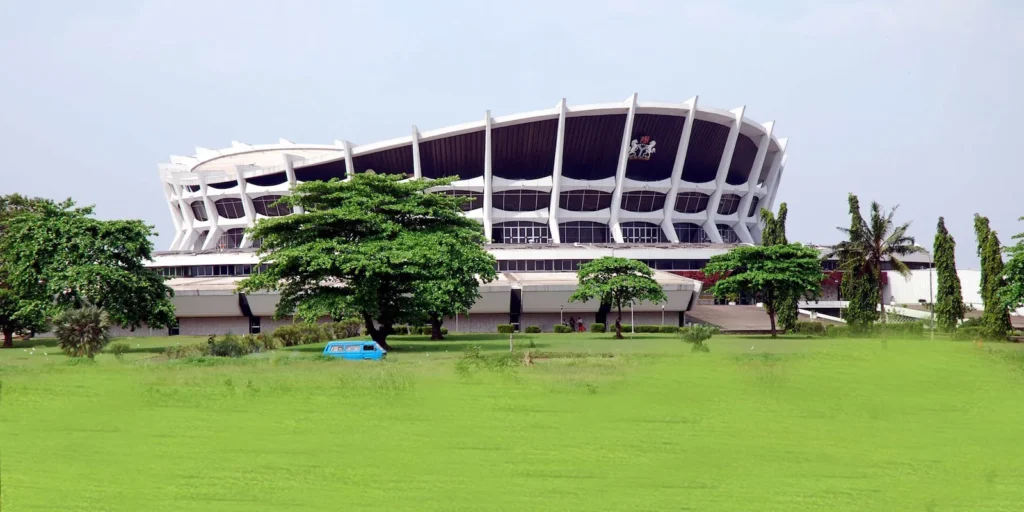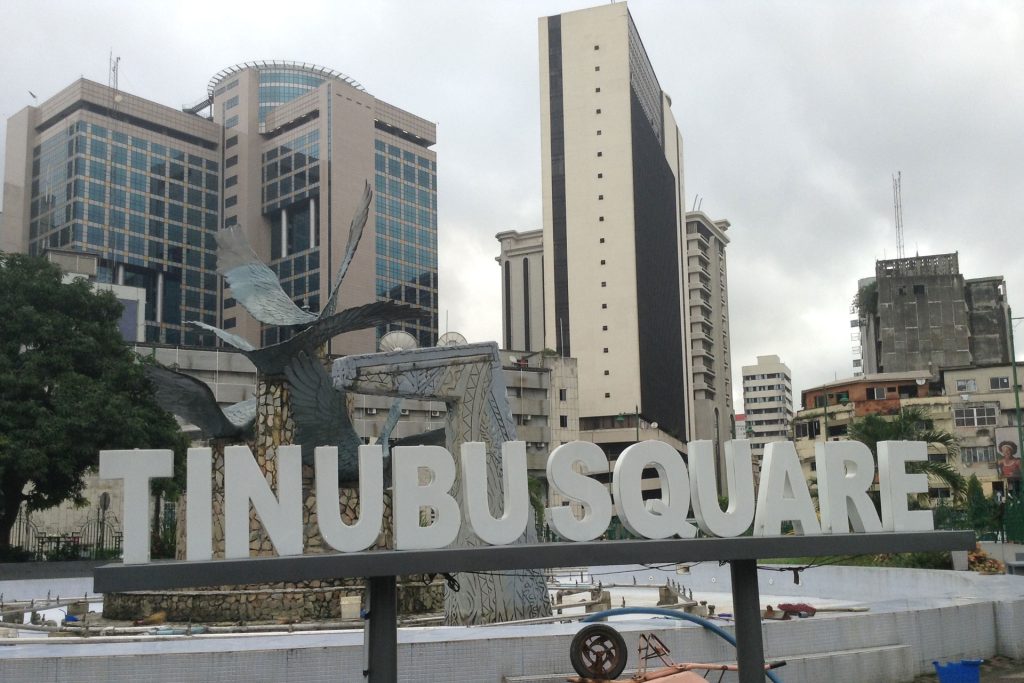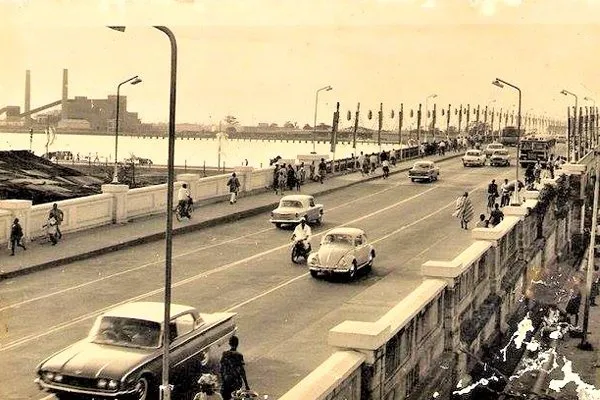Exploring Lagos Landmarks: Eko Bridge, National Stadium, National Theatre, Tinubu Square, Carter Bridge
The National Stadium in Surulere, Lagos, Nigeria, is a prominent sports facility and an iconic landmark in the country. Here’s an overview:
Location:
The National Stadium is located in the Surulere district of Lagos, Nigeria. It is one of the major sports complexes in the country and has played a central role in hosting various sporting events and activities.
History:
The National Stadium was originally constructed in 1972 to host the 1973 All-Africa Games. It was officially named the “Lagos National Stadium” but is commonly referred to as the National Stadium. The stadium has since hosted numerous local and international sporting events, including football matches, athletics competitions, and cultural events.
Facilities:
The stadium complex encompasses various facilities designed for a range of sporting activities. These include:
- Main Bowl: The main bowl is the central arena primarily used for football matches and athletics events. It has hosted significant football competitions and other sports events.
- Indoor Sports Hall: The stadium features an indoor sports hall for sports like basketball, table tennis, and other indoor games.
- Swimming Pool: There is a swimming pool within the stadium complex for aquatic sports and events.
- Tennis Courts: The complex includes tennis courts for tennis enthusiasts and tournaments.

Historical Significance:
The National Stadium has historical significance as a venue that has witnessed various milestones in Nigerian sports history. It has hosted major football matches, athletic competitions, and cultural events, contributing to the country’s sports legacy.
Maintenance and Renovation:
Over the years, the National Stadium has undergone maintenance and renovation efforts to ensure that its facilities meet modern standards. However, there have been concerns about the state of the stadium, and discussions about further renovations and improvements have taken place.

Community Use:
Apart from hosting national and international events, the National Stadium is also used by the local community for sports and recreational activities. It serves as a hub for athletes, sports enthusiasts, and the general public.
Cultural and Entertainment Events:
In addition to sports activities, the National Stadium occasionally hosts cultural and entertainment events, showcasing a diverse range of talents and performances.
National Theatre: Lagos Cultural Landmark

The National Theatre in Lagos, Nigeria, is a prominent cultural landmark and performing arts venue. Here’s an overview:
Location:
The National Theatre is located in Iganmu, a suburb of Lagos. It stands along the Ebute-Metta-Lagos Mainland expressway, not far from Tafawa Balewa Square.
History:
The National Theatre was commissioned for construction in 1973 and completed in 1976. It was built in preparation for the Festival of Arts and Culture (FESTAC) held in Nigeria in 1977. The architectural design of the National Theatre is a notable example of modernist and brutalist architecture.
Architectural Design:
The National Theatre features a distinctive exterior with an imposing structure, showcasing modern architectural elements. The design includes a 5,000-seater Main Hall, a 1,000-seater Conference Hall, and other facilities for various performing arts activities.
Cultural Significance:
The National Theatre serves as a major cultural center and plays a significant role in promoting the arts in Nigeria. It hosts a wide range of events, including theatrical performances, concerts, dance shows, and cultural exhibitions.
Facilities:
- Main Hall: The Main Hall is the largest auditorium within the National Theatre, suitable for large-scale performances and events.
- Conference Hall: The Conference Hall is designed for conferences, seminars, and smaller gatherings.
- Exhibition Halls: There are spaces within the National Theatre dedicated to art exhibitions, showcasing the works of Nigerian and international artists.
Challenges and Renovation:
Over the years, the National Theatre faced challenges such as maintenance issues and a need for renovations. In recent times, there have been initiatives to revitalize and renovate the National Theatre complex to restore its cultural significance and improve its facilities.
Tourism:
The National Theatre is a tourist attraction in Lagos, drawing visitors who are interested in the arts and cultural heritage of Nigeria. The complex not only serves as a performance venue but also as a place for cultural exchange and appreciation.
Government Involvement:
The National Theatre is often under the management of government agencies involved in cultural affairs, and it has been a focal point for national events and celebrations.
Eko Bridge: Lagos Monument

The Eko Bridge is a significant monument and a vital transportation infrastructure in Lagos, Nigeria. Here’s an overview of the Eko Bridge:
Location:
The Eko Bridge is located in Lagos, spanning the Lagos Lagoon to connect the Lagos Island to the mainland. It plays a crucial role in facilitating movement between the island and the mainland
It was the first major project undertaken by Julius Berger which was approved by Shehu Shagari who was then the Minister of Works during Nigeria’s First Republic.
The bridge starts from Ijora on the mainland and ends at the Apongbon area of Lagos Island. The lagoon section of the bridge spans a distance of 430 metres. The bridge and its landward extension of 1350 metres were constructed in phases between 1965 and 1975.
Key Features:
- Construction and Opening: The Eko Bridge was commissioned for use in 1968. It was constructed to alleviate traffic congestion and improve connectivity between Lagos Island and the mainland.
- Structural Design: The bridge is a complex engineering structure with multiple spans and piers. It is designed to accommodate vehicular and pedestrian traffic.
- Length: The Eko Bridge is approximately 430 meters long, providing a significant crossing over the Lagos Lagoon.
- Traffic Significance: Eko Bridge is a major route for commuters traveling between the densely populated Lagos Island and the mainland. It is an essential part of the city’s transportation network.
- Nighttime Illumination: Similar to other prominent bridges in Lagos, the Eko Bridge is often illuminated at night, creating a visually striking scene and contributing to the city’s skyline.
Tips for Visitors:
- Photography: The Eko Bridge offers opportunities for photography, especially during sunset or nighttime when it is illuminated.
- Traffic Considerations: Due to its importance in the transportation network, traffic conditions on the bridge can vary. It’s advisable to plan visits during non-peak hours to avoid congestion.
- Pedestrian Walkways: The bridge has designated walkways for pedestrians, providing an alternative for those who prefer to walk or take in the views on foot.
- Maintenance Schedules: Check for any scheduled maintenance or repair works, as this may impact traffic flow. Periodic closures may occur for maintenance purposes.
The Eko Bridge stands as a symbol of Lagos’s growth and development. It is not only a critical transportation artery but also a recognizable landmark that has become an integral part of the city’s identity. As with any infrastructure, conditions and offerings can change, so it’s advisable to check with local sources or recent visitors for the latest information before planning a visit to the Eko Bridge in Lagos.
Tinubu Square – A Monumental Ground in Lagos Nigeria

Tinubu Square, formerly known as Independence Square, is located in Broad Street, Lagos Island, Lagos State, Nigeria. It was named after Madam Efunroye Tinubu, a Yoruba slave trader, merchant, and aristocrat. The square was formerly called Ita Tinubu before being named Independence Square and subsequently Tinubu Square
Historical Significance:
According to a historian, Tinubu Square was the location of the first court of justice, which was replaced in 1918 by the Supreme Court or the Court of Assizes, a magnificent structure. The square served as a melting point for different cultures, where indigenous Lagosians, individuals of Brazilian extract, and the colonial administration met.
Structure:
Tinubu Square is iron-fenced and features two flowing fountains, flowers, and tropical trees. A life-size statue of Madam Tinubu is situated on a cenotaph within the square. The size of the square is 2,000 square meters. It was last remodeled in 2017 by the Lagos state government.
Environment:
Tinubu Square is described as a serene location, and efforts are being made by the “Keep Lagos Clean” operation to make the square a place for tourism and a center of attraction. The square’s environment is likely maintained to enhance its appeal to visitors and residents alike.
It has some magnificent sculptures like the Eagles, the statue of Madam Tinubu, statue of Lagos’ popular blind minstrel Kokoro the Drummer and the Reclining Reader. The greenery of the well-groomed plants blends well with the water fountains to give a very breathtaking and grand scenery.
Carter Bridge: Lagos History & Significance

The Carter Bridge, constructed in 1901, is one of the three bridges connecting Lagos Island to the mainland, the others being the Third Mainland and Eko bridges. Originally, it was the sole bridge linking the mainland to Lagos Island.
The bridge spans from Iddo on the mainland to the Idumota area of Lagos Island. It was named after Sir Gilbert Thomas Carter, a former Governor of the Colony of Lagos.
Built by the British colonial government, the Carter Bridge underwent reconstruction in the late 1970s after Nigeria gained independence in 1960. The Alaka-Ijora flyover, situated at the Iddo end of the span, was completed in 1973.
Over the years, the bridge has faced challenges, including severe road congestion and rapid deterioration caused by the parking of vehicles on it. Concerns about the potential collapse of the span due to vehicle parking led to the Lagos State government implementing a ₦50,000 fine for offenders.

Additionally, in April 2006, the Lagos State Transport Commissioner announced a ban on all commercial vehicles entering Lagos Island via the Carter Bridge to prevent congestion caused by buses and other vehicles parking on the bridge.
Furthermore, the lack of streetlights on the bridge made it unsafe at night. To address this, in July 2013, Governor Fashola commissioned streetlights on Carter Bridge, powered by an Independent Power Project. The initiative was executed by the State’s Electricity Board using local components and technicians.
Related Reading Discovering Lagos, Nigeria: Lagos Lagoon, Lekki Conservation Centre, Murtala Muhammed International Airport, Freedom Park

